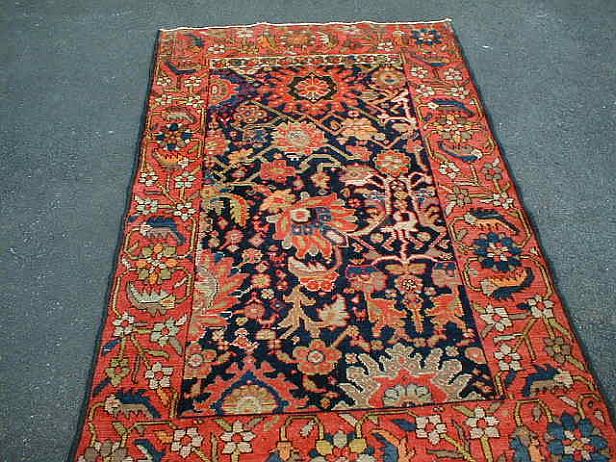Posted by R. John Howe on 08-31-2006 05:37 PM:
Jerry’s Thompson’s Subtle Sampler, Plus One
Dear folks –
We mentioned in the initial essay that there are samplers that are difficult
to recognize and that Jerry Thompson owned one such.
I wrote Jerry and his wife Kaye, asking if they would be willing to share images
of this piece.
They have done so and have also sent a photo of one other wagireh they own.
Here are two views of the subtle one. The first is head on and you can see the
small white-ground stripe at the top edge of the field that triggered Jerry’s
suspicion

The second side image below is to let you see the bottom end of this piece.

Jerry said “the blue field piece is a Hamadan woven with characteristic Sultanabad
design elements.”
It seems to me that this is arguably a wagireh of the "strike-off" sort, in
which the visible question is "Should we use this white-ground border or not?"
Jerry also sent along another vagireh he owns:

He said “the predominantly green field piece is a Mahal.”
Our thanks to Jerry, and to Kaye, for sharing these two interesting pieces with
us.
Regards,
R. John Howe
Posted by R. John Howe on 09-03-2006 07:49 AM:
Dear folks -
I should have mentioned, as I put it up, that I find Jerry Thompson's Hammadan
"strike-off" type sampler very attractive.
I like the large scale of the drawing (notice both that of the borders and of
the field are pretty large but they seem not to compete) and the red is of the
sort that draws me to old Hammadans even when they do not have in other respects
aspects that might make them "collectible."
Regards,
R. John Howe
Posted by Richard Larkin on 09-03-2006 12:33 PM:
beauty
Hi John,
I’m with you on the attractive qualities of the Hamadan area wagireh. In truth,
I like the Mahal, too. I have always admired the best of these types, i. e.,
old Mahals and this kind of Hamadan. Whether they are “collectible,” or merely
“decorative,” or other adjectives we could muster, I will pass on that discussion.
I think the Hamadan is especially successful because, although assymetrical
in design, it is visually balanced (a phrase loaned by my sweetie, a talented
designer) by the strong role played by the palmette in the center, as set off
by the devices at the two ends. That feature, coupled with the scale of both
the field and border[s], as you pointed out, and the good and lively color,
combine to give the rug great appeal. (I think the sample auxiliary border stuck
in there is more harmless, design-wise, than anything else one might say. Maybe
it is another bit of asymmetry that gives the rug vigor.)
The Mahal has a very different affect, but it is nothing if not mellow. Congrats
to Jerry and Kaye, and may they prosper with both pieces
__________________
Rich Larkin
Posted by R. John Howe on 09-06-2006 10:54 AM:
Dear folks -
In another thread Pat Weiler makes an interesting comment about the second piece
above. I have copied it here below for convenient reference.

He says "...the second wagireh in a different thread, Jerry Thompson's Subtle
Sampler, appears to contain only what appear to be border designs or minor motifs,
no medallion parts or major field designs. Perhaps it was used as one of several
that were needed for one big rug."
My thought:
This is an interesting reading of the designs in this wagireh. I had thought,
without actually considering it much, that the green area was field and the
rectilinear "branches" part of a potential field "tree" design and that the
yellow ground trangular area was a corner bracket.
How do others read this Mahal wagireh?
Regards,
R. John Howe
Posted by Steve Price on 09-06-2006 10:58 AM:
Hi John
My guess would have been the same as yours.
One thing about this one that I find intriguing is that it is surrounded by
a single border design. I'd have thought that the surrounding border would be
the perfect place to put a little sample of several borders, or of one in several
color combinations.
Regards
Steve Price
Posted by R. John Howe on 09-06-2006 04:40 PM:
Steve -
I admit to not having access to the controlling logic for this wagireh (and
for that of most others) but I wonder if they were not sometimes made in situations
in which some things had been settled (agreed) and other things were still to
be decided.
In this case could it be that the outside border seemed the minor border most
likely to be used and the red ground area with the "palmettes" had been selected
as the major border but there was mostly a question of whether an alternative
minor border (the white ground one) might be used instead?
Just my speculation, but one that for me makes sense of what is included in
the design of this particular wagireh.
Regards,
R. John Howe


